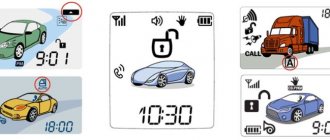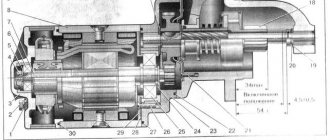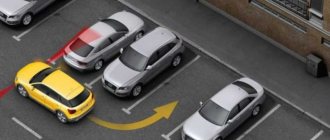Good day, dear readers! The other day, having found myself in several unpleasant situations on the road and being shocked by the driving of some “drivers,” I once again decided to write a few words about the rules of the road. Quite recently, I wrote about how you can quickly learn traffic rules, since I repeat once again that their knowledge by all road users is the key to our safety, dear drivers. Today, the next rule is a rule that is explained in any driving school even before the start of the driving course. Moreover, the most interesting thing is that for the most part it is known only to drivers, and participants on foot do not always understand what is being said. So, for your attention there is a rule of interference on the right.
How to understand and when to use “interference from the right”
As such, you will never find a rule called “interference on the right” or a “right hand” rule in the text of the traffic rules, but any driver will easily tell you its essence. In Section 8 of the Traffic Regulations you can read the following:
This is nothing more than the “interference from the right” rule. And it will change only in cases when:
- vehicles are equivalent: as you know, the tram for the most part has priority (except for the case of leaving the depot), therefore this phrase must be understood in the following interpretation, that all vehicles are trackless or vice versa, it is necessary to determine the order of passage of trams;
- vehicles are in equal conditions, for example, both are moving along a main/secondary/equivalent road or at a green traffic light;
- It is not possible to determine the order of travel using more conventional methods (road signs, traffic lights).
That is, this rule applies when driving around in the parking lot of a supermarket, in courtyards and in any adjacent areas. But it does not need to be used if you are leaving the yard or other adjacent territory, since even in the absence of priority signs, the person leaving must give way.
Interference on the right when driving through unequal intersections
Let's consider clause 13.10 of the traffic rules:
13.10. In the event that the main road changes direction at an intersection, drivers moving along the main road must follow the rules for driving through intersections of equivalent roads. Drivers driving on secondary roads should follow the same rules.
This paragraph states that if the main road changes direction at an intersection, then drivers must follow the rules for driving at equivalent intersections, i.e. the “Interference on the right” rule.
At the intersection of unequal roads, the “Interference on the right” rule applies only in the following cases:
- A white car is moving along the main road, which turns right. He must give way to a red car that is entering the intersection on the main road and approaching from the right. This issue is discussed in detail in the article “Driving at unregulated intersections on the main road.”
- The blue car is driving along a secondary road that "turns" to the right. She must give way to an orange car entering the intersection on a secondary road and approaching from the right. In addition, the blue one must give way to all cars entering the intersection on the main road (white, red). This issue is discussed in detail in the article “Driving at unregulated intersections on a secondary road.”
Determining the order of passage of intersections
According to Section 13 of the Traffic Regulations, the order of passage of any intersection is determined by:
- gestures of the traffic controller, he is the one in charge at the intersection, his gestures have more weight than traffic lights and priority signs, that is, if the traffic light is green and you have a main road, and the traffic controller prohibits movement, then under no circumstances should you drive;
- traffic light signals, in the “table of ranks” they are below the traffic controller, but higher than the priority signs;
- the actual priority signs themselves, such as the main road, intersection with a secondary road, give way, driving without stopping is prohibited, etc. If there is no traffic controller and traffic light at the intersection, then we are guided by them;
- road surface, in the absence of signs you can always navigate along it, because a hard surface road (asphalt, asphalt concrete) will always be the main one in relation to the dirt road.
If the order cannot be determined using the above, then it’s time to apply the “right hand” rule, well known in driving circles.
Example:
A car, let’s call it “A,” is moving straight on a green signal; a car “B” is also driving towards it on a green signal, which wants to turn left. A conflict situation is brewing: both have green lights on, and their trajectories intersect. A way out of the situation is possible only by applying the “right hand” rule. When car “B” starts to turn, it will have an obstacle on the right in the form of an approaching car “A”, so it must give way.
Do not forget that when determining the order of passage of a car and a tram, the “interference on the right” rule cannot be applied under any circumstances; this could result in a serious collision with a 20-ton colossus.
Right hand rule and difficult traffic situations
The road consists of sections of varying difficulty. For example, in urban environments, the paths of several vehicles often intersect. To safely overcome some of them, you should take into account obstacles on the right.
At an equivalent intersection
When driving through an intersection of equivalent roads, the driver must give way to the car that is on the right. This is prescribed by paragraph 13.11 of the traffic rules. This provision applies only to intersections where there are no traffic lights, traffic controllers, or road signs that establish the order of passage.
In other words, the right-hand rule applies to uncontrolled intersections.
This type of intersection can be defined in the following cases:
- if there is a road sign “intersection of equivalent roads”;
- a sign on the side of the road that marks the end of the main road;
- when there are no priority signs.
Thus, the rule of interference on the right can be applied at an intersection if it is unregulated and the paths are equivalent. If there are signs, signs, or appropriate markings, then you need to follow them when moving.
On a left turn
Interference on the right has absolutely no correlation with turning left or making a U-turn.
According to clause 13.12 of the traffic rules, the driver of a wheeled vehicle, when turning left or making a U-turn, is obliged to give way to everything that is moving towards him on an equivalent road straight ahead or to the right.
Even drivers of oncoming trams should be guided by this principle. Thus, the traffic rules for such maneuvers do not provide for the use of the concept of “interference on the right.”
When changing lanes
When driving on a road with several lanes, the car may change lanes. When changing lanes, it is important to comply with safety requirements. To do this, it is better to adhere to the traffic rules. When simply changing lanes, the driver must allow absolutely all vehicles moving in the same direction in a certain lane to pass without changing direction.
The “right hand rule” comes into play when two vehicles change lanes at the same time. Here you should give way to the vehicle on the right. It does not matter whether the cars are at the same level or one in front of the other.
The rules for changing lanes are prescribed in section 10 of the traffic rules.
Here special attention is paid to safety. Before performing this action, the driver must make sure that he does not create obstacles or hinder the movement of other vehicles. You must always use your turn signals to warn others.
The car on the left cannot change lanes if it would cause the other driver to brake suddenly or change direction.
Applying the rule when changing lanes
Rebuildings can be divided into 2 groups:
- Simple (only one vehicle is rebuilt);
- Complex or mutual, the name speaks for itself; in this case, a simultaneous reconstruction of the vehicle occurs.
When simply rearranging questions, no rule always dictates that you give way to the participant who changes something. And here the one who is rebuilding gives way. But with simultaneous (mutual) restructuring, the order is determined by applying the rule of interference from the right.
Penalty for violating the “third hand” rule
The table of penalties literally does not contain an article for violating the “interference on the right” rule. But if the requirement to cede the right of priority passage in accordance with the “Interference on the right” rule is not met, certain articles of the Code of Administrative Offenses come into force:
- Article 12.13, part 2 – if the violation occurred at an intersection, the penalty is a fine of 1000 rubles;
- Art. 12.14.h. 3 – violation of the rules of priority travel, with the exception of Art. 12.13 p.m. 3 and 12.17 of the Code of Administrative Offences, as punishment a verbal warning is issued or a fine of 500 rubles is issued;
- Art. 12.17 – it talks about not granting the right of way to a route vehicle or a car with flashing lights on, special. sound signal (siren), external color schemes, here a fine of 500 to 3,000 rubles is issued, or deprivation of the right to drive for 1-3 months, depending on the complexity of the case.
Thus, in the APN protocol, the traffic police inspector will indicate a violation of a specific clause and issue a fine under the appropriate clause of the Code of Administrative Offenses for failure to comply with the requirement to provide priority travel.
The “Interference on the right” rule applies only in cases where the case does not fit within the framework described in the traffic rules.
Who should give way
In order to understand the issue even better, it is necessary to consider several of the most common situations. Of course, it is worth remembering the dynamism of events and the need to quickly analyze changing conditions: for example, some may turn on the turn signal too late, which can immediately change the driving conditions.
On equivalent roads
This is the most common use of the principle of interference on the right: at an intersection it operates clearly and makes it easy to understand the order of movement. There are a few simple tips to remember:
- When approaching an intersection, assess the situation in advance and predict in what order the traffic participants will pass. Slow down before an intersection, even if you can go first.
- If one of the cars has already begun the maneuver and can create interference, let it pass the danger zone and only then move.
- When temporary signs are installed, follow them, even if the intersection is equivalent. This also applies to the main priority signs - temporary ones always take precedence and are valid until they are removed.
- Be careful when moving large equipment. Sometimes it makes sense to stop even if the paths do not intersect, since due to its large size there is a high risk of collision.
Be sure to check for signs, even if they are not visible. Trees and other objects often limit your view, but you can see signs from other directions. If they exist, you should be guided by them so as not to create an emergency situation.
In the yards
Although driveways in residential areas are not considered public roads, they are subject to the same rules as when driving through intersections. There are most often no signs in such territories, so the right-hand rule is used as the main rule in any situations requiring priority determination of passage.
For your information! Many motorists, when one side of a long passage in the yard is occupied by stationary vehicles, mistakenly believe that the one leaving the residential area has the right of way. In fact, the vehicle on whose side the parked cars are parked is required to give way.
When it comes to sidings, through driveways take precedence over small spur driveways. This also applies to options when a paved road is adjacent to a dirt or gravel road: asphalt areas always have an advantage.
When it comes to leaving a parking lot, when two cars are moving at the same time, the one with an obstacle on the right gives way. But you always need to give way to vehicles moving along the passage, even if it is on the right side.
When changing lanes
Another situation where you need to use the right hand rule. But in this case there are some peculiarities that are worth examining in order to prevent emergency situations on the road. All recommendations are given for public roads with two or more lanes in one direction:
- Regardless of the maneuver and direction of changing lanes, the car that moves in its lane and does not change lanes has an advantage. She always passes first.
- The rule for changing lanes at the same time is the same as in other situations: the one with the obstacle on the right must give way.
Any maneuvering requires attention, since at the moment the lane change begins it may turn out that someone has already taken the lane. Therefore, it is important to assess the road situation and begin the maneuver when there is no danger of an accident.
How to properly avoid obstacles on the left or right
And so in some situations you can come across a sign 4. 2 3 detour around obstacles on the left and right. This sign will give the driver the opportunity to choose his own route for further travel.
This can often be found when repairing the roadway, or roads in the middle of the street. It is recommended to choose the right side to go around the obstacle, but still this sign gives you the right to choose yourself, but it is still better to go around on the left side as a last resort. Of course, there will be no fine, this serves to prevent an accident in the oncoming lane.
It is important to understand that traffic violations can lead to serious injury and death.
Bypassing a continuous line
Nowadays, situations such as blocking of some sections of the road often arise due to various reasons. The bus punctured a tire, there was an accident, repair work and much more. And then the driver begins to panic and turn off the vehicle. And wait for the problem to be resolved in this area, or jump through the solid line. According to statistics, most vehicle owners choose option number two.
But think about it: generally, traffic police officers regard crossing a solid line as a gross violation of traffic rules. Which may entail a small fine.
Unfortunately, the traffic rules do not have a clear concept of what detour or overtaking is. Here you will need to understand and take into account the code of administrative violations, namely Article 12. 15. In this section it will be written in detail that a detour in such cases can be considered as a maneuver, due to an obstacle due to which it is impossible to continue the movement of traffic. Please note that driving on your side is prohibited. Even at a low speed, then this action will be considered as overtaking and a traffic violation.
What to do at a crossroads
Sometimes there are situations when drivers at an intersection can rely on the right-hand rule.
There are times when it is not easy to separate. Most often, controversial situations arise at an intersection with equal traffic, where no signs are installed, and drivers moving towards each other in a straight line are about to turn right and left, i.e. in the same direction. It seems that in this case no one is bothering anyone, but when turning, one vehicle will interfere with another. To avoid an accident, you should rely on the right-hand rule. The driver who is obstructed on the right when turning oncoming traffic must yield.
Video on the topic is below.
The right hand rule is a generally accepted method for resolving controversial issues when moving. If there are no priority signs, traffic lights or traffic controllers, then travel is regulated by this rule, except for leaving the yard, parking, stopping place and parking lot.
Why is the motorcycle not an obstacle on the right?
The orange or yellow flashing light is not
gives advantages in traffic, therefore, you, guided by the rules for driving through intersections of equivalent roads, must give way only to
a motorcycle
approaching
from the right
.
Interesting materials:
Why doesn't my Samsung phone see Wi-Fi? Why does my Samsung phone reboot itself? Why does my Xiaomi phone discharge quickly? Why does my phone have poor Wi-Fi reception? Why did the phone begin to charge quickly? Why does my phone lose Wi-Fi network? Why is the phone turned on but they can’t get through? Why does my phone turn off at 30 percent charge? Why does the phone turn off at 30 percent? Why does my Samsung Galaxy phone charge very slowly?
Rule of three Ds, or give way to the fool
According to many experienced drivers who have many years of accident-free driving experience, knowing the “interference on the right” rule when changing lanes is, of course, good, but in many cases, ordinary human politeness, not regulated by any rules, helps to avoid an accident, or even just a conflict situation. Car registration? In addition, banal attentiveness is also important.
The following situation often occurs. When driving onto the road from a yard or other adjacent area, the driver thinks that they must let him through, because he is sure that the obstacle on the right looks exactly like this. In fact, he must wait for the end of the traffic flow, since he enters the main road from the secondary one. The following scenario cannot be ruled out.
A car leaving a secondary road manages to jump out in front of a car on the main road and takes the “correct” position on the lane, but is immediately hit by another car, whose driver does not have time to react. Determining the degree of guilt in such a situation is not so easy, especially in the absence of a DVR. Here it is more appropriate to yield to the driver from the secondary road, “applying” the three D rule.
What can be an obstacle to traffic on the road?
In clause 1.2. The rules clearly indicate what may be an obstacle:
- inoperative or damaged vehicle;
- road defect;
- any foreign objects.
However, the above list is not exhaustive due to its presence in the definition specified in clause 1.2. Rules, the words “and. etc.”
Here are examples of what can be considered an obstacle on the road:
- a car that made a forced stop due to a burst tire or other technical malfunction;
- hole, failure or other defect in the road surface;
- a tree falling on the roadway;
- various carcasses of animals hit by other drivers;
- barriers put up by road workers in connection with road repairs, etc.
The Rules also clearly state what is not considered an obstacle. The list is exhaustive and consists of 2 items:
- congestion, that is, a traffic jam;
- a vehicle stopped in a traffic lane in accordance with the requirements of Section 12 of the Rules.
For example, two motorcycles without a side trailer, placed in two rows near the edge of the roadway, will not be an obstacle, even if they interfere with driving along the lane.
At the same time, if a car stops on the lane, violating the Rules, it (the car) will already be considered an obstacle. For example, a stopped vehicle will be an obstacle if the distance between it and the solid marking line is less than 3 meters (paragraph 4 of clause 12.4 of the Rules).
When the rule doesn't apply
There are several strictly regulated traffic situations that do not allow you to focus on the “right hand”:
— conflict with the tram (the latter is always a priority, for example, if you are driving along the same road and the tram turns right);
— unequal positions (priority on the road is determined by traffic rules when entering a circular road);
Give Way Sign: Functions, Exceptions and Consequences (Memo)
— presence of signs and traffic lights prescribing priority rules.
Rebuilding
According to traffic rules, obstruction on the right when changing lanes requires the passage of vehicles located to the right of the one making the maneuver. For example, one traffic participant decides to change lanes to the right. In this case, he has an obstacle on the right and he is obliged to let through all the cars that interfere with the maneuver.
Another situation: the driver wants to change lanes to the right, and the vehicle on the right plans to move to the left, i.e., vehicles are supposed to change lanes at the same time. In this case, the left driver is obliged to let the one who is still driving in the right lane pass, waiting until he completes the maneuver. And only after that it performs a rebuild.











